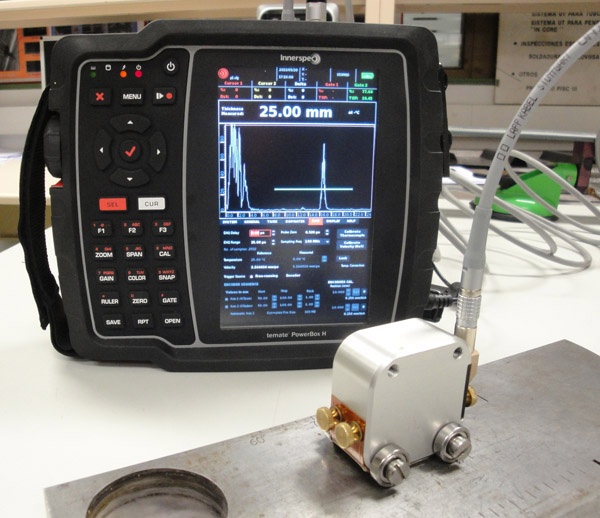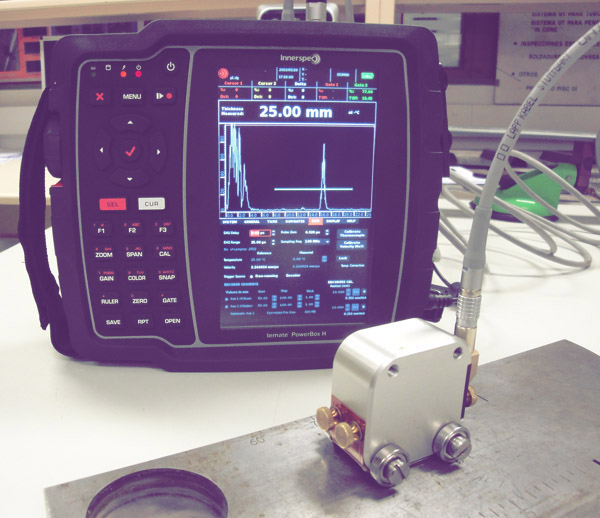In a previous article we explained that it was possible to generate an ultrasonic beam in a material without the need for any part of the inspection system to be in contact with the part to be inspected.
In the case of ultrasounds generated by EMAT, we will make use of electromagnetic phenomena to generate an elastic wave in the part to be inspected and, in this way, propagate ultrasonic waves inside the material without the need for the probe to be in contact with it.
Do you know what EMAT stands for?
EMAT is the acronym of ElectroMagnetic Acoustic Transducers.
This means that transducers of this type manage to generate acoustic waves on the basis of electromagnetic phenomena. OK, so now you will be asking yourself: How can I convert an electromagnetic field into an elastic wave, which is what is actually need? Let us explain this.
How are EMAT ultrasonics generated?
An EMAT system generates ultrasonic waves in a metallic object through interaction between two fields: an electrical field generated by coils with a relatively high frequency (RF) current passing through them interacting with a low or static frequency (SF) magnetic field generated by magnets.
This combination of fields interacts with the material, elastically and periodically displacing particles on its surface and ‘voilà’, a mechanical wave has been generated inside the part. From now on this wave will be transmitted as an ultrasound, which is something with which it is used to working.
Given that it is a reciprocal process, the interaction of elastic waves on the surface of the material in the presence of a magnetic field induces an electrical current in the EMAT receiver, the wave being detected following a phenomenon of reflection with any existing discontinuity.
The two physical phenomena applied in EMAT technology are Lorentz’s law and the magnetostrictive effect. If you would like more detailed information on these two phenomena, please indicate this in the comments section.

Characteristics of EMAT technology
The main characteristic of EMAT technology is the fact that the ultrasonic wave is generated directly in the material to be inspected. This peculiarity is shared with other technologies such as laser ultrasounds.
Advantages and disadvantages of EMAT
Set out below, as a way of rounding off this initial look at EMAT technology, are the advantages and the limitations currently implied by the technique:
Advantages of EMAT technology:
- Contactless: although proximity is preferable, it is not essential (<10 mm; decreases with increasing frequency).
- No coupling medium: simple automation; high inspection rates; inspection at low and high temperatures (from -50°C to 200°C in continuous mode and up to 650ºC with cooling).
- Less sensitive to surface conditions: inspection of rough, irregular, curved, rusted, painted or soiled surfaces.
- Simple probes: there is no variation of the ultrasonic signal between different probes.
- Unique wave modes: possibility of generating transversal horizontal (SH) waves and simple generation of guided waves (Rayleigh and Lamb).
Limitations of EMAT technology:
- Exclusive for conducting (metallic) materials: inspection not feasible in the case of plastics, ceramic materials and glass fibre and highly inefficient for carbon fibre.
- Low transmission efficiency: need for high power (100 A across the coil produces a response of few μV).
- Low signal-noise ratio: requires signal processing algorithms.
- Geometric limitations: large-sized probes because of the physical characteristics of the coils and magnets.
- Precaution regarding the use of magnetic materials: handling of high-power magnets.
If you think that this article has been interesting and would like to delve deeper into other aspects of this technology or others relating to non-destructive testing, please indicate this in the comments section.
Author: Covadonga Garcia






